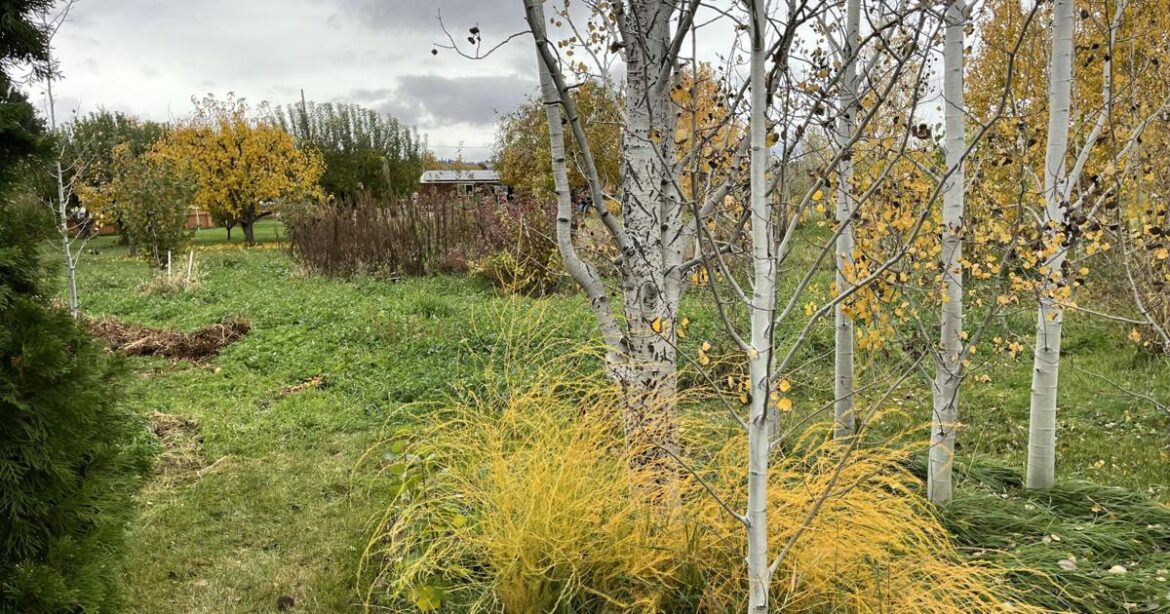The last zucchini has been harvested, frost has brought an end to tomato season and birds are enjoying the few remaining sunflower seeds. It’s time to start planning next year’s garden if you hope to encourage more visits by butterflies and moths.
Butterflies and moths visit a garden for food and shelter. They do not visit to intentionally pollinate your fruits and vegetables. Pollination happens when pollen is transferred from the male to the female part of the flower. This is an accidental process that happens when pollen sticking to the body of a pollinator rubs off on the appropriate plant part during a visit.
It’s time to start planning next year’s garden if you hope to encourage more visits by butterflies and moths.
Photo courtesy of Don Flyckt
Butterflies and moths are significantly less efficient pollinators than bees. Bees are interested in both nectar and pollen while butterflies and moths are interested in only nectar. Nectar is rich in sugars and provides the energy adults require to fly and lay eggs. Adult butterflies and moths will visit many different species of flowers while foraging for nectar. This behavior helps them survive but makes them less efficient pollinators since pollination requires the transfer of pollen from the same species.
Butterflies and moths are also less efficient pollinators than bees because their bodies are designed with long legs and tongues which seldom contact pollen directly. A bee’s body is designed to directly contact pollen and is equipped with specialized body parts to collect it.
Butterflies and moths do have a significant role. They are important pollinators for some agricultural crops and flowers. They are a critical part of the food chain for birds, lizards, spiders, dragonflies and other invertebrates. In the caterpillar stage, they are voracious eaters and help control plant populations.
Possibly their most important role is as an indicator of a healthy environment. Butterflies and moths are very sensitive to environmental changes and require specific conditions to thrive. A robust population signifies a healthy environment with sufficient food plants, intact habitat and a stable climate.
Butterflies and moths have several different strategies to survive winter or other extended periods of inclement weather. Many species overwinter in a dormant, hibernating state. They rely on protective habitats like leaf litter, tree bark crevices or dense vegetation to protect the overwintering eggs, caterpillars or pupae.
Of the butterfly species that survive the winter by migrating, Monarchs are the most well-known. This butterfly flies south to overwinter and returns north the following spring. The adult butterfly that begins this journey is not the one that finishes it. The female lays eggs on milkweed plants as she travels. She dies along the way, but her descendants gradually return northward over two or three generations.
Butterflies and moths require two different plant varieties to survive, one for the caterpillar and a second for the adult.
Most species will lay their eggs on a few closely related plants. After hatching, the caterpillars eat the leaves or flowers of the host plant, partially or completely consuming it. Caterpillars can be very picky about their food, so picky that some will starve if they cannot find their preferred host plants.
The Carolina Sphinx moth is the result of a very difficult choice gardeners make when they decide to encourage visits from butterflies and moths. This impressive moth has a wingspan of 3 to 5 inches and in flight resembles a hummingbird. The caterpillar stage is the Tobacco Hornworm, a very large green caterpillar with a distinctive red or pink horn and infamous for its ability to damage tomato plants. To allow this caterpillar to mature into an adult, the gardener must tolerate the destruction of their precious tomato plants.
Benign neglect gardening is an approach that may help some gardeners provide the food and habitat butterflies and moths require. This approach involves minimal intervention and resilient plants to encourage a natural and balanced ecosystem. It requires providing an area in your garden to provide shelter and food. Typically, this garden has an untidy and messy appearance where caterpillars are allowed to damage or potentially destroy plants.
For this type of garden, select native and non-native plants that are well-adapted to your site, have a year-round interest, and provide flowers from early spring until late fall. Native trees, shrubs and flowers are some of the most important caterpillar host plants and sources of nectar for the adults. Native plants evolved alongside the butterflies and moths to provide the food they need, and at the time it is needed.
Benign neglect gardening is not simply allowing an area to go wild. It requires that gardening tasks are performed in a manner that restores balance. Knowing when and how to prune, irrigate and remove noxious weeds and invasives is critical. Also important is monitoring and removing underperforming plants and replacing them with new species when necessary.
Maintaining an area of benign neglect is challenging in that your efforts may not be fully appreciated by neighbors and friends. They may be more tolerant of your efforts if your area includes a path and tidy edges to present the illusion of order.
Seeing more butterflies and moths may be your only reward.
However, I have found that explaining to a neighbor why it is exciting to have caterpillars destroying my plants is a very rewarding experience.


Comments are closed.